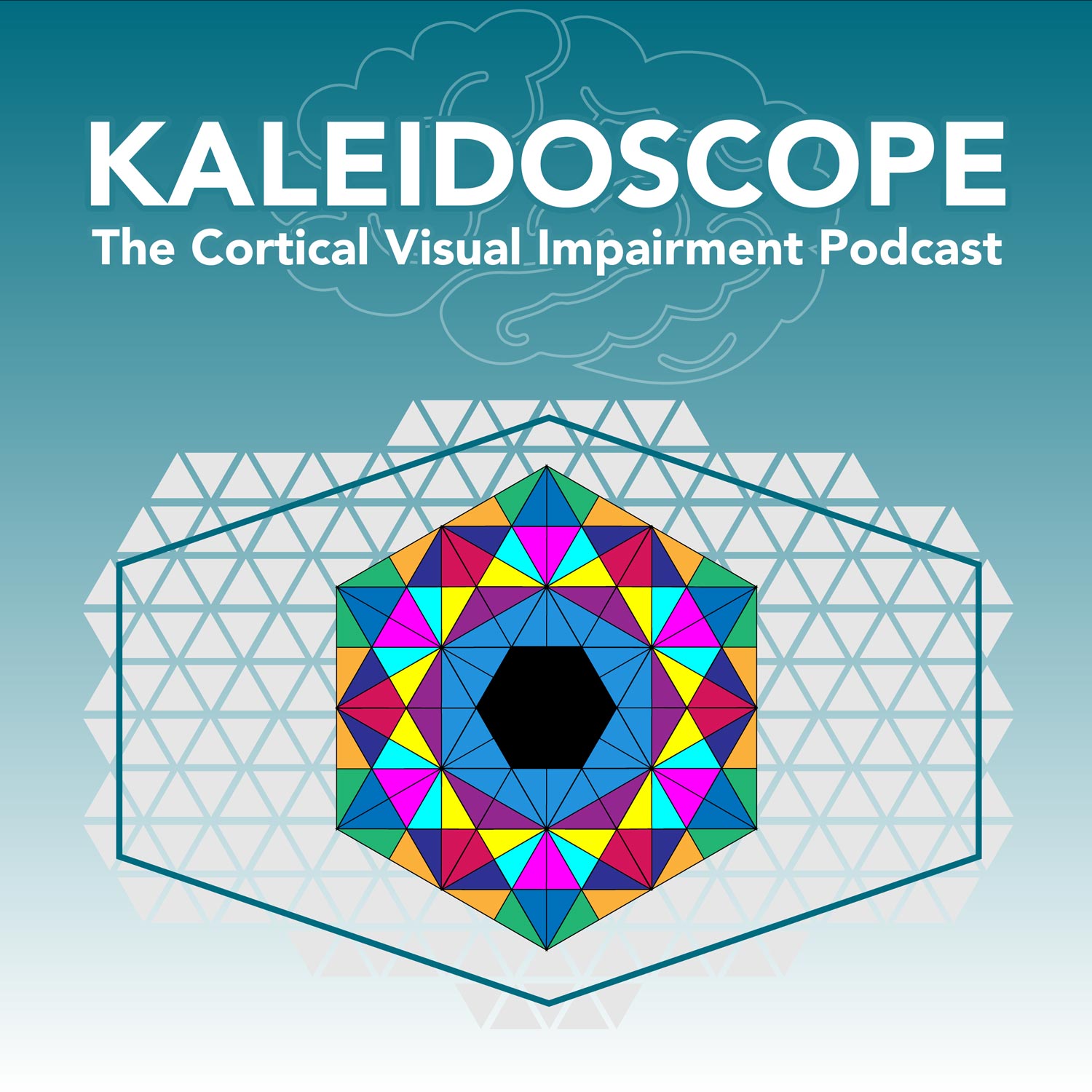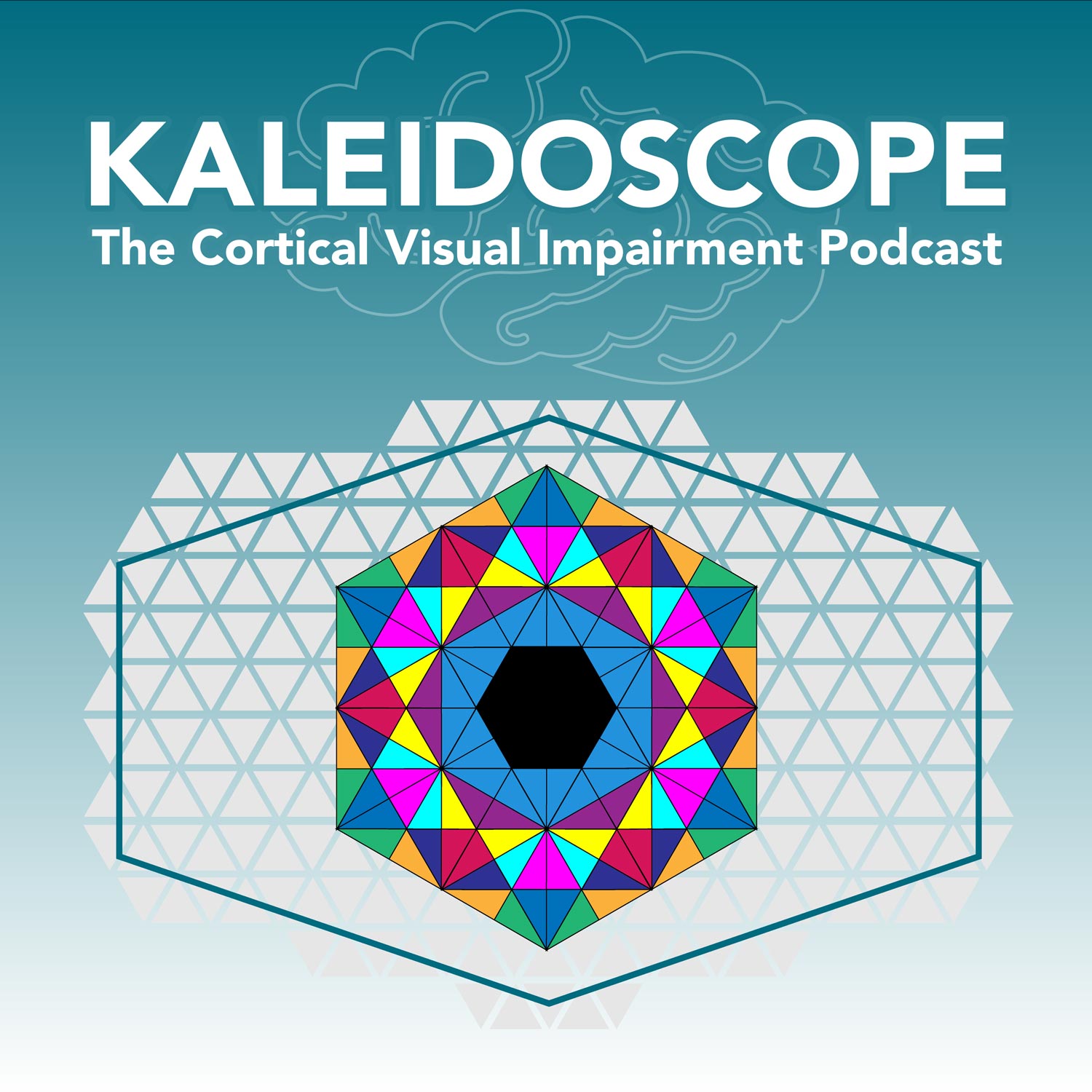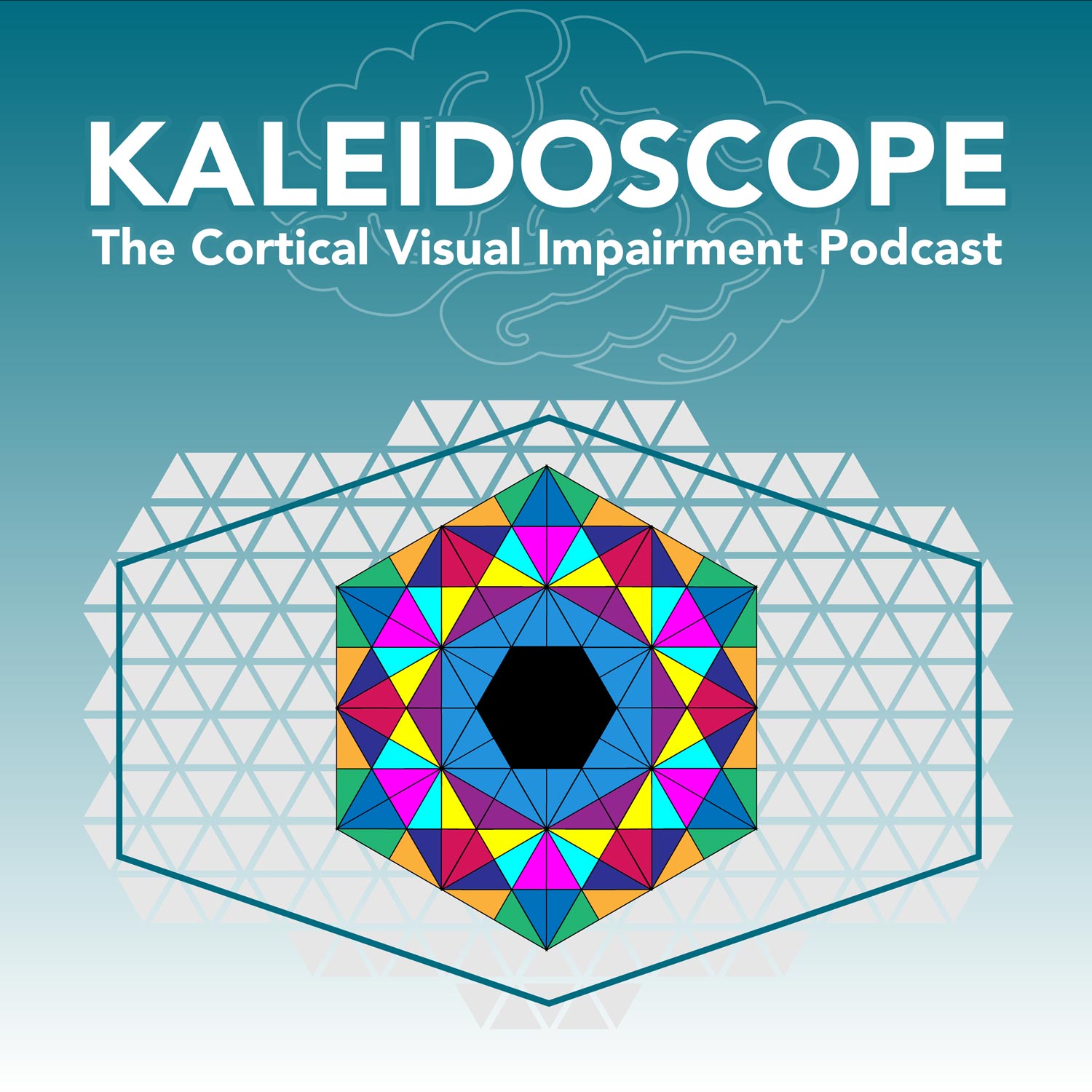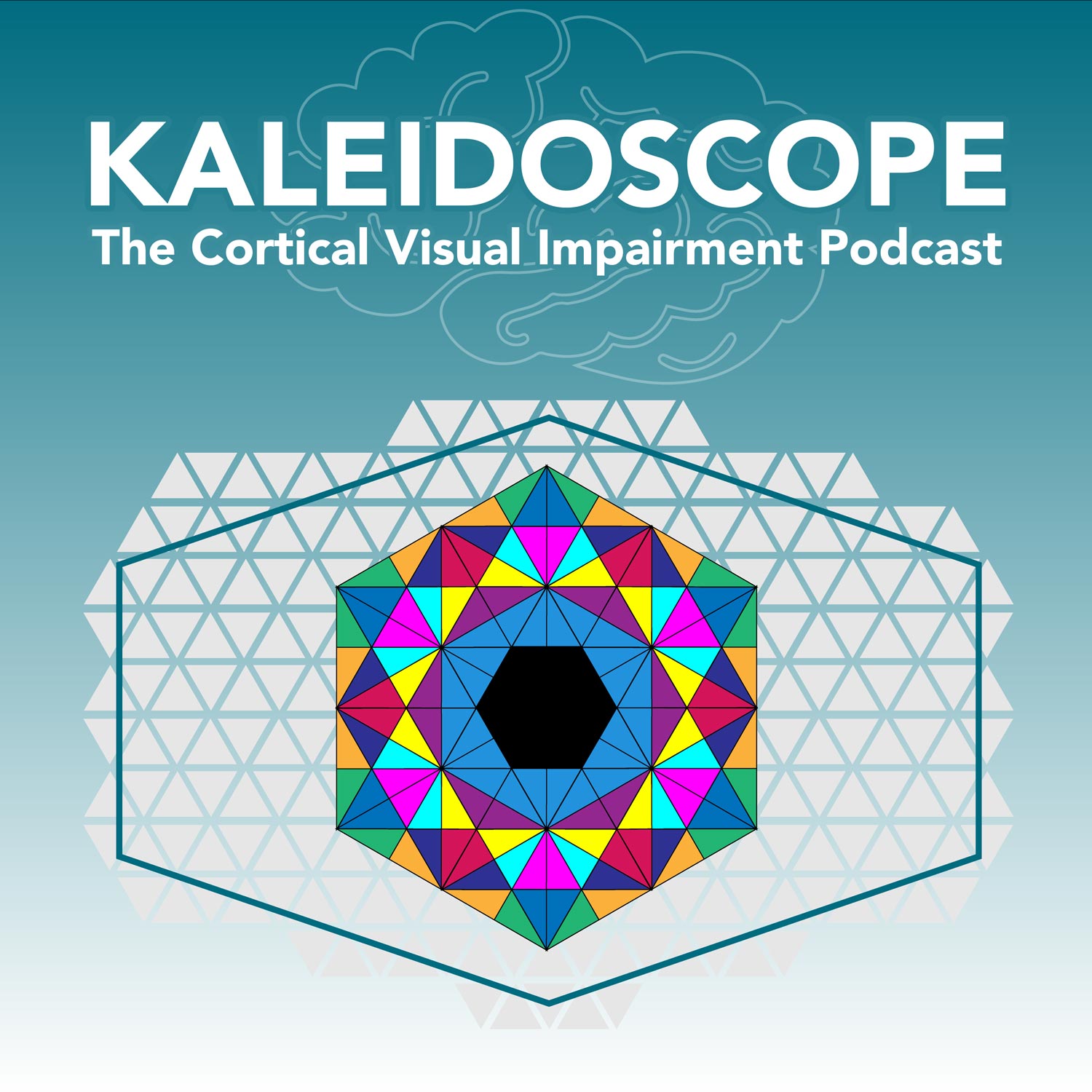Discover Kaleidoscope: The Cortical Visual Impairment Podcast
Kaleidoscope: The Cortical Visual Impairment Podcast

Kaleidoscope: The Cortical Visual Impairment Podcast
Author: Jessica Marquardt
Subscribed: 29Played: 261Subscribe
Share
© Jessica Marquardt
Description
Cortical visual impairment (CVI) is the leading cause of pediatric visual impairment in the developed world. The eyes can see, but the brain can't interpret the visual world. Due to neuroplasticity, the functional vision of a child with CVI can improve. The number of children with CVI is growing, so why isn't anyone talking about this public health crisis? We are.
Music by Storm Crews. Art by Ian Kleinfeld.
Music by Storm Crews. Art by Ian Kleinfeld.
17 Episodes
Reverse
Cindy Younan, founder of cvijourney.com and mother to Valentina (1.5 years), describes the day during her pregnancy when she found out about her daughter’s complications. There have been highs, lows and personal sacrifices since then, which Cindy has embraced with a positive spirit. We talk about what went through her mind when she heard the terms severe ventriculomegaly, hydrocephalus and cortical visual impairment for the first time – and the steps she’s taken to educate herself and other parents who are experiencing the same thing. Resources: cvijourney.com Surrey Place Perkins CVI Symposium Wrap-Up Podcast Pediatric Cortical Visual Impairment Society Perkins CVI Hub Constraint Induced Movement Therapy (CIMT) Anat Baniel Method
Kira Brady tells the journey to her son’s diagnoses, which include cerebral palsy (CP), periventricular leukomalacia (PVL) and cortical visual impairment (CVI). We marvel at how it can be so difficult to get a diagnosis even when, in hindsight, Mason is considered a “textbook” case. A few things come up: Throwing chairs in the library. When a child doesn’t recognize his classmates. A former student who paved the way. Transitioning to kindergarten during a pandemic. Resources: Cerebral Palsy Foundation Cerebral Palsy and Visual Impairment in Children, Scottish Sensory Centre CVI Scotland Perkins eLearning The Boy Who Could Run, but Not Walk by Karen Pape Understanding Facial Recognition Difficulties in Children by Nancy L. Mindick
Barbara Lopez Avila has a PhD in developmental psychology. But she says she still feels ill-prepared to help her son Logan navigate life with cortical visual impairment (CVI). How can that be? She writes in a recent blog post for the Pediatric Cortical Visual Impairment Society, “…while CVI is the leading cause of pediatric visual impairment in developed countries, the medical as well as the educational communities are still far behind in knowing how to diagnose and treat CVI. This leaves parents of children with CVI in much uncertainty about what to do to best help their children.” Barbara recognizes that she can’t do this alone. So, she’s taken an active role in assembling and collaborating with a team of educational and medical providers who know about CVI or, at the very least, are willing to learn about the condition and how it affects her son. We talk about finding our CVI tribe to accompany us on the journey…
Grace (8) is a vibrant second grader with lots to say. She describes what it’s like to live with cortical visual impairment – the things that upset her and the special characteristics she relies on day-to-day. She says, “I’m not afraid to speak up.” And so she does.
Cheyanne Marcy has been an advocate on big stages, on everyday social media platforms and in day-to-day life on behalf of her son, Archer (5). She values action and advocacy – and has navigated not one, not two, but three state education systems. She writes, “… I learned I was not doing enough to advocate for my child’s needs. Advocacy begins in your home, with our family and friends. It is all too easy to clam up and keep quiet. Sometimes feeling like you are explaining things over and over, then these people are close to you, so offense is taken. The challenge exists consistently.” We sit down to talk about overcoming the fear of speaking up, vital services and resources for kids with CVI and NeuroMovement. Resources: Lighthouse Guild Tele-Support Enrollment or email moderator Judith Millman NeuroMovement practitioner Sylvia Shordike Find a NeuroMovement practitioner near you NeuroMovement sparkingtheneurons.blogspot.com
Mia Carella of thismomwithablog.com shares wisdom from the head and the heart, which comes from navigating life as a CVI mom / heart mom. (Her daughter Evalyn, 8, has cortical visual impairment and a congenital heart defect.) Mia describes the ups and downs of being a special needs parent and why we should let go of the Super Mom ideal. In this episode: 2:05 – Dance programs for kids with special needs 4:45 – Moving from feeling helpless to feeling more empowered as a mom 9:20 – Explaining rare genetic disorders and little-known conditions, like CVI, to doctors #CVIsplaining 11:30 – What CVI means for Evalyn (late Phase II CVI) in her day-to-day life 13:20 – Advocating for CVI needs in an IEP meeting 18:30 – Participating in The Miracle League and making baseball adaptations 23:50 – What our kids teach us about resilience, positive outlooks and perspective 26:19 – How her blog has changed her life Resources: thismomwithablog.com pcvis.vision The Miracle League
Tommy Szalapski – Google accessibility engineer and CVI dad – has created a new app for CVI literacy. The Roman Word Bubbling project automates the tedious process of adding color outlining to letters, numbers and words, based on Dr. Christine Roman’s CVI literacy research and methodology. Tommy describes this project, Google’s Lookout app and emerging technologies that will benefit people with cortical visual impairment, like his daughter Jocelyn (9). Resources mentioned: Roman Word Bubbling project Cortical Visual Impairment: Advanced Principles, C. Roman (2019) CSUN Assistive Technology Conference Bookshare More on Lookout: With Lookout, discover your surroundings with the help of AI Google Play Announcing the Lookout app
Rosalie (1.5) has hydrocephalus, a build-up of fluid in the cavities deep within the brain, which comes with the risk of vision problems. She received a cortical visual impairment (CVI) diagnosis from an ophthalmologist who provided her parents with accurate information, for instance: CVI is a brain-based visual impairment, her brain can learn to better understand what she sees as it makes new connections, she needs more time to look at things, and really bright colors and movement will draw her attention to objects. The doctor referred Rosalie to the state agency for vision services, but that’s where the CVI conversation stopped. “I did not have a good understanding in the moment what CVI really meant and kind of like the magnitude of how it really impacts every aspect of every day and every little thing we've been doing with her,” says her mother, Stephanie Kung. “And the fact that it's a disability that is never going to leave her. I really just didn't understand that or get a sense of that until I went home and immediately started researching and, you know, obsessively learning all that I could.” Not only did Stephanie quickly sift through the research and implement CVI-friendly strategies and routines, she started a blog called Everyday CVI, where she documents life hacks, tips and tricks for families raising a child with CVI. Stephanie talks about Rosalie’s tremendous progress, how to advocate for CVI-appropriate early intervention services and that moment when you realize you are a special needs parent. Resources mentioned in this episode: Everyday CVI Little Bear Sees Start Seeing CVI Cortical Visual Impairment: An Approach to Assessment and Intervention Perkins School for the Blind CVI Hub
When Emma (16) received a cortical visual impairment diagnosis at age four, CVI literature was not widely available. The consensus was “this is just what she has, live with it,” says her mother, Lynn Elko. Her family didn’t know great gains could be made. They didn’t know how to help her learn or meet developmental milestones. Then Lynn discovered what kids with CVI can accomplish with strategic, appropriate interventions that give them visual access to the world. And that changed everything. After six months living with appropriate CVI strategies in place, Emma made tremendous progress in many areas, including feeding, communication, social engagement and literacy. While Emma’s renaissance has overjoyed her family, there is also the heartbreak of not knowing sooner. Over the years they tried ocular approaches, which turned out to be “horrible and so inappropriate,” says Lynn. “We were trying everything. I think that’s what is so hard, that I missed it. And everyone in the field missed it.” The system broke down in many places – we hear this story time and again. “We cannot let other kids be Emma. We cannot let them go without appropriate interventions and services and knowledgeable staff and knowledgeable providers – because there’s hope for our kids. Because they can learn. Because they can make themselves less vulnerable when they make themselves more able. Because they’ll have a better quality of life when they’re given an opportunity to participate in it.” I couldn’t have put it better myself. Resources and events we mention: Fifth Annual Perkins CVI Symposium – July 11-12, 2019, at Perkins School for the Blind in Watertown, MA Pediatric Cortical Visual Impairment Society Annual Meeting – July 13, 2019 at Perkins Augmentative and Alternative Communication (AAC) Proloquo2Go More on literacy strategies, including bubble words and the importance of color highlighting in Cortical Visual Impairment Advanced Principles by Dr. Christine Roman (2019) and why the iPad is a great tool for CVI on CVI and the iPad
Judy Endicott works with her grandson River (9) on his reading skills, relying on her background as a special educator and continuing education in CVI principles and practices. How does she manage to keep up with his needs, including the countless custom materials he requires to access print? What techniques does she use to motivate him to practice? Judy talks about putting the CVI overlay on River’s reading curriculum. Some suggested resources: Cortical Visual Impairment Advanced Principles, (Roman 2019) Gail Gibbons Books Book Creator App Bitsboard App Google Slides
I’m reflecting on 2018. For me, this has been the Year of the CVI Advocate. My life has been transformed by my interactions with fellow CVI parent advocates – online, at conferences and through this podcast. From Start Seeing CVI Advocacy on Facebook to Boston for the CVI Symposium to Omaha for the American Conference on Pediatric Visual Impairment back to Boston for CVI Family Vacation – and even from my closet here in Raleigh – I’ve interacted with some pretty amazing humans who have made this journey start to feel meaningful. I also had a unique opportunity to take a leave of absence from work this summer to concentrate on my daughter Grace, which may be something I’ll share more about later… To sum it up, it’s been a stellar – and at times upsetting – year. We parent advocates have found some strength and cohesion. This is good. So, what next? Well, let me share what I’ve learned this year. Bottom line: this is a sprawling issue. We all know there is a lack of general awareness and that CVI is complex – our kids have a wide spectrum of issues (related to and not related their visual abilities). This makes parent advocacy more important than ever. And I’ve heard from vision professionals that they are pleased to see us strengthen our ranks, but…. We are too much. Too angry. Too combative. Too passionate. They say our advocacy is misguided and there’s potential that we’ll drive away experienced professionals. Sigh. Yet, if you ask, most people think we should be treated as equal partners on our child’s team. Sounds contradictory to me, but I think I can rationalize it. Professionals often feel at a loss when it comes to helping our children. They want to help, but no one was taught how to identify CVI and intervene. I would feel defensive – and do sometimes as a parent – if I was supposed to have the answers and didn’t. Doctors and educators need continuing education and mentorship from those in the know. CVI courses are not a dedicated part of their preparation programs, one of the primary problems in my humble opinion. Our medical system is letting down families. Medical experts recognize this. It can be hard to get a diagnosis. And if you do, it can take up to a year to get a follow-up appointment with a specialist. On top that, there is not a standardized set of tools for diagnosis and evaluation. The ICD-10 codes are misrepresentative – you know this if your child was diagnosed with the outdated term “cortical blindness.” Just another hurdle to getting a proper diagnosis. Truly problematic: We aren’t screening infants who are likely to have CVI. You know, preemies, kids with a history of a neurological event, etc. Scary but true, kids are being misdiagnosed with Autism Spectrum Disorder. We are missing kids. Then we look at the world of education. University programs are failing to adequately prepare vision educators to meet the specialized needs of students with CVI. Only one program, U Mass Boston, requires students to take a course on CVI. But how much of these programs is dedicated to preparing educators to teach braille? What vision educators are learning does not match the population of children they do or will serve. On top of that, we have a TVI shortage and, in some states, loosy goosy standards for what makes a TVI in the first place. What’s largely in the way of solving these problems? Well, we are quite preoccupied with questioning assessment tools like the CVI Range, leaving us little time to make progress on other topics. While some are questioning it, many parents know the value of the CVI Range – how it helps us characterize our children’s needs and intervene appropriately. By the way, there is a replication study on the reliability and validity of the CVI Range in the works. If we use the CVI Range with our kids, does that mean that other assessment
Sisters Anna Ault and Lori Kinney are raising daughters with visual impairments. One has cortical visual impairment, the other an ocular visual impairment. We discuss their parallel but unique experiences advocating for CVI and Leber’s congenital amaurosis. They are raising their kids in the same community – their childhood community, in fact. Their girls are close in age and attend the same public-school system. But as Anna and Lori compare their experiences, it becomes evident that there are fundamental differences between a brain-based visual impairment and an eye-based one. In this episode: Resources for getting up-to-speed on a visual diagnosis. The prevalence of CVI and the rarity of LCA. The effect of CVI and LCA on day-to-day activities. IEPs and school services. Giving back. Resources we mentioned: Pediatric Cortical Visual Impairment Society (PCVI Society) The RDH12 Fund for Sight The American Conference on Pediatric Cortical Visual Impairment 2018 CVI Symposium hosted by Perkins School for the Blind Olivia’s Pediatric CVI Society Fundraising Page Start Seeing CVI Advocacy
Opera performance student Dagbjört Andrésdóttir gives us a glimpse into her life with cortical visual impairment, describing music and strong parental support as her saving grace. “I kind of knew always there was something, but I wasn’t sure if it was my vision or something else,” says Dagbjört. Three years ago, with the help of her mother, she concluded that CVI was the culprit. To parents she says, “You know your children better than anybody – any physician, any teacher, any person in the world…if you have a hunch there’s some problems, follow it. Don’t give up on it.” In this episode: Stumbling upon a diagnosis. Challenges of growing up with CVI. Advice for parents of kids with CVI. Difficulties with new and complex environments. Developing strength in other senses. Start Seeing CVI Advocacy Perkins CVI Family Vacation
Krish (6) received an early CVI diagnosis and guidance from a teacher of the visually impaired who knew how to intervene appropriately, based on his CVI Range score. With neuroplasticity and dedicated parents on his side, he’s heading to kindergarten with improved functional vision and a CVI-rich IEP. In this episode: Coming to terms with the CVI diagnosis. Moving from Phase I to Phase III (Roman). Integrating CVI strategies into the daily routine. What makes an IEP appropriate for a child with CVI? Partners on the Journey: A TVI and Family’s CVI Experience from Birth to Age 3 Start Seeing CVI Advocacy
When Alisha Waugh and her husband learned that their son Griffen (10) has a cortical visual impairment (CVI), they committed to improving his functional vision above all else – and with stellar results. Alisha puts her Perkins-Roman CVI Range Endorsement to work each and every day for Griffen. She is also serving other kids with CVI and their families through her consultancy Fundamentals First. In this episode: Common behaviors seen in children with CVI. Fundamental tools and accommodations needed to access the school curriculum. Steps toward reading fluency. Supporting your child’s social and emotional well-being. A provider’s perspective on best practices for kids with CVI. Fundamentals First (whattodoaboutcvi.com) Start Seeing CVI Advocacy
Henry (5) has a new cortical visual impairment (CVI) diagnosis. His mom, Rachel, now understands why he is so frustrated. He can't interpret what he sees. Relying on the 10 characteristics of CVI, they infuse vision into everything they do. His vision has improved, and his whole being has too. Not only has Rachel fully embraced the educational approach based on the research of Dr. Christine Roman, she and a group of other CVI moms are building a collective national movement to advocate for kids with CVI so that every child has the chance to progress. In this episode: The path to a CVI diagnosis. Learning that vision can improve. Changes to daily routines to accommodate for CVI characteristics. Becoming a tiger mom. Preparing for elementary school. Cortical Visual Impairment: A Timeline Start Seeing CVI Advocacy
Grace (6) reads sight words, enjoys hearing chapter books and shows an affinity for math. Yet she can’t interpret illustrations in a children’s book or recognize the faces of her mother and father. Her parents on the struggles and joys of raising a child with cortical visual impairment. In this episode: An early diagnosis but a late understanding of its implications. The “aha!” moment – a reframed diagnosis. Getting a CVI Range assessment from Dr. Christine Roman. Working with and within the public school system. Braille vs. print. Surprises and delights that come with raising a child with CVI. Pediatric Cortical Visual Impairment Society Cortical Visual Impairment: An Approach to Assessment and Intervention CVI Hub: Perkins eLearning Start Seeing CVI Advocacy





















